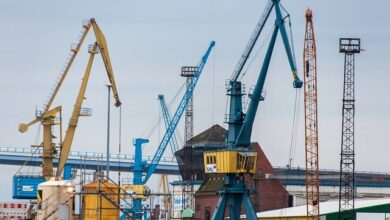Drone Delivery Systems and Logistics Applications

In today’s fast-paced world, the logistics industry is constantly seeking innovative solutions to streamline operations and enhance efficiency. One technology that has captured the imagination of both businesses and consumers alike is drone delivery systems. With their ability to navigate the skies and reach remote locations with ease, drones are revolutionizing the way goods are transported. In this article, we will explore the fascinating world of drone delivery systems and their wide-ranging applications in logistics.
Imagine a future where your package arrives swiftly and directly to your doorstep, bypassing traffic congestion and long delivery times. That’s the promise of drone delivery systems. These unmanned aerial vehicles (UAVs) are equipped with advanced sensors, cameras, and GPS technology, enabling them to autonomously navigate through the air while avoiding obstacles.
One key advantage of drone delivery is its incredible speed. While traditional delivery methods can take hours or even days, drones can cover significant distances in a fraction of the time. This rapid delivery capability is particularly crucial for urgent medical supplies, perishable goods, or time-sensitive deliveries.
Drone delivery systems also offer unparalleled accessibility. They can reach remote areas, disaster-stricken regions, or geographically challenging locations where traditional means of transportation may be impractical. This opens up new opportunities for businesses to serve customers in previously underserved markets.
Furthermore, drones are environmentally friendly. Unlike conventional delivery trucks or vans, they produce zero emissions and have a significantly smaller carbon footprint. With the increasing focus on sustainability and eco-friendly practices, drone delivery systems align perfectly with these goals.
While the potential of drone delivery systems is immense, there are still challenges to overcome. Regulatory frameworks need to adapt to ensure safe and responsible operation of drones in airspace. Additionally, technological advancements should continue to enhance battery life, payload capacity, and navigation accuracy.

Drone delivery systems are transforming the logistics landscape. Their speed, accessibility, and eco-friendly nature make them an ideal solution for various industries. As technology progresses and regulations evolve, we can expect to see drones become an integral part of the logistics ecosystem, delivering goods faster, more efficiently, and with fewer environmental impacts than ever before. Exciting times lie ahead as we embrace the limitless possibilities of drone delivery systems.
Revolutionizing Supply Chains: How Drone Delivery Systems are Transforming Logistics
Picture this: a sleek, futuristic drone soaring through the sky, effortlessly carrying packages to their destinations. It’s not just imagination anymore; it’s the reality of logistics in the 21st century. Drone delivery systems are revolutionizing supply chains and transforming the way goods are transported from one place to another.
Gone are the days of relying solely on traditional means of transportation like trucks and ships. Drones offer a faster, more efficient alternative that can navigate through congested roads and deliver packages directly to customers’ doorsteps. With their ability to bypass traffic and take direct routes, drones are cutting down delivery times and enhancing customer satisfaction.

One of the key advantages of drone delivery systems is their ability to reach remote or hard-to-access areas. Imagine a medical emergency in a rural village where time is of the essence. Drones can swiftly transport life-saving supplies or medication to those in need, bridging the gap between inaccessible locations and essential resources.
Moreover, drones are environmentally friendly. They run on electricity and produce zero emissions, making them a greener option compared to conventional vehicles. In a world increasingly concerned about sustainability, using drones for deliveries aligns with eco-conscious values.
But how do these unmanned aerial vehicles ensure the safety and security of packages? Advanced technologies such as GPS tracking, obstacle detection, and automated landing systems enable drones to navigate with precision and avoid collisions. Additionally, robust encryption and authentication protocols safeguard sensitive data and prevent unauthorized access.

As drone technology continues to advance, the potential applications in logistics are expanding. From delivering groceries to monitoring inventory levels, drones are streamlining operations and reducing costs for businesses. They provide real-time data and insights, enabling companies to optimize their supply chain management and make informed decisions.
Drone delivery systems are transforming logistics by introducing speed, efficiency, and accessibility. They are revolutionizing supply chains, making deliveries faster, reducing environmental impact, and opening up new possibilities for businesses. With their ability to navigate obstacles and reach remote areas, drones are reshaping the future of logistics and revolutionizing the way goods are transported worldwide. The sky is no longer the limit; it’s just the beginning for drone-powered logistics.
Speed and Efficiency Unleashed: Exploring the Future of Drone Delivery in Logistics
Picture a world where packages zip through the sky, bypassing traffic and reaching their destinations in record time. This is the future that drone delivery holds for the logistics industry. With the advent of technology, drones are poised to revolutionize the way goods are transported, offering unparalleled speed, efficiency, and convenience.
Drone delivery has the potential to transform the logistics landscape by overcoming traditional challenges faced in transportation. No longer bound by congested roads or limited by infrastructure, drones can swiftly navigate from point A to point B, avoiding traffic jams and reducing delivery times. Imagine receiving your much-awaited package within hours instead of days, all thanks to these aerial wonders.
But how exactly do drones achieve such impressive results? Powered by advanced algorithms and cutting-edge sensors, these autonomous flying machines can effortlessly determine optimal routes, avoiding obstacles and adjusting their flight path in real-time. This level of adaptability ensures seamless navigation, even in complex urban environments.
Not only do drones offer exceptional speed, but they also enhance operational efficiency. Traditional last-mile delivery often requires multiple stops and human resources, resulting in increased costs and potential delays. Drones, on the other hand, can efficiently complete deliveries with minimal human intervention, streamlining the process and reducing expenses for logistics companies.
Moreover, drone delivery systems can be integrated with existing logistics networks, complementing traditional modes of transportation. They can act as efficient couriers, seamlessly transferring packages between warehouses, distribution centers, and even ships or trucks. This integration optimizes the entire supply chain, enabling faster and more cost-effective delivery options.
In addition to their speed and efficiency, drones also have a positive environmental impact. By minimizing reliance on traditional vehicles, they reduce carbon emissions and contribute to a greener future. This sustainable approach aligns with the growing demand for eco-friendly solutions, making drone delivery an attractive option for environmentally conscious consumers and businesses alike.
The future of drone delivery in logistics is both awe-inspiring and game-changing. These airborne marvels offer unrivaled speed, efficiency, and cost-effectiveness for delivering goods. With their ability to navigate complex environments and integrate seamlessly into existing networks, drones are poised to revolutionize the way packages are transported. Embracing this technology promises a faster, more efficient, and environmentally friendly future for logistics operations worldwide.
From Packages to Pizzas: Drones Take Flight in the Delivery Industry
Imagine a future where your packages arrive at your doorstep not by a delivery person, but by a small flying machine. It may sound like something straight out of a science fiction movie, but drones are rapidly revolutionizing the delivery industry, making it faster, more efficient, and ultimately more convenient for consumers.

Drones, also known as unmanned aerial vehicles (UAVs), have come a long way from their military origins. They have increasingly found applications in various industries, including delivery services. With advancements in technology, these flying wonders are now capable of delivering a wide range of goods, from packages to even piping hot pizzas.
One of the main advantages of drone delivery is speed. Traditional delivery methods can be hindered by traffic congestion and other logistical challenges. However, drones can bypass these obstacles by taking direct routes through the sky. This means that your order can reach you in a fraction of the time it would take for a delivery truck to navigate busy streets.
Not only are drones fast, but they also offer unparalleled accessibility. In remote areas or places with limited infrastructure, such as islands or mountainous regions, drones can deliver items with ease. This opens up new possibilities for reaching customers who were previously excluded from efficient delivery services.
Furthermore, drone delivery has the potential to reduce carbon emissions and minimize the environmental impact of transportation. By utilizing electric-powered drones, companies can significantly decrease their reliance on fossil fuels and contribute to a greener future. This eco-friendly approach aligns with the increasing demand for sustainable practices and resonates with environmentally conscious consumers.
Of course, there are still challenges to overcome before drone delivery becomes commonplace. Issues related to safety, regulations, and public acceptance need to be addressed. However, as technology continues to advance and regulations evolve, we can expect drones to become an integral part of the delivery industry.
Drones are transforming the way goods are delivered, from packages to pizzas. With their speed, accessibility, and potential environmental benefits, they offer a promising alternative to traditional delivery methods. As the delivery industry embraces this exciting technology, we can look forward to a future where our orders take flight, arriving at our doorsteps with astonishing efficiency and amazement.
Breaking Borders: The Global Impact of Drone Delivery Systems on Logistics

Imagine a world where packages soar through the sky like birds, effortlessly navigating their way to our doorsteps. This futuristic vision is becoming a reality with the advent of drone delivery systems, revolutionizing the field of logistics. In this article, we will explore the details of how these unmanned aerial vehicles are breaking borders and making a global impact on the world of logistics.
Drone delivery systems have emerged as a game-changer in the logistics industry. These small aircraft equipped with advanced technology are capable of carrying out deliveries faster, more efficiently, and with reduced costs. By bypassing traditional transportation methods such as roads and highways, drones can reach remote locations and congested urban areas with ease. This opens up new possibilities for businesses, especially those operating in challenging terrains or last-mile delivery scenarios.
One of the key advantages of drone delivery systems is their ability to overcome geographical barriers. In regions with limited or poorly developed infrastructure, such as rural areas or disaster-stricken zones, drones offer a lifeline for delivering essential supplies, medical aid, and even humanitarian assistance. They can swiftly reach inaccessible locations, saving valuable time and potentially saving lives.
Moreover, drone delivery systems significantly reduce the carbon footprint associated with traditional delivery methods. With fewer trucks on the road, emissions are lowered, contributing to a cleaner and more sustainable environment. This aligns perfectly with the growing demand for eco-friendly practices across industries.
By harnessing the power of artificial intelligence and machine learning, drones can optimize their routes and adapt to changing conditions in real-time. They can navigate obstacles, avoid collisions, and ensure secure and accurate deliveries. With advancements in sensor technology, drones are becoming increasingly sophisticated, capable of detecting and avoiding birds, buildings, and even other drones.
While the potential for drone delivery systems is vast, several challenges need to be addressed. Concerns related to privacy, security, and regulations must be carefully managed to ensure the safe and responsible use of drones. Collaboration between industry stakeholders, policymakers, and regulatory bodies is crucial in shaping a framework that allows the widespread adoption of this technology while mitigating potential risks.
Drone delivery systems are transforming the logistics landscape on a global scale. Their ability to overcome geographical barriers, reduce carbon emissions, and optimize deliveries makes them a disruptive force in the industry. As we break the borders of traditional logistics, drones are soaring high, promising a future where packages traverse the skies to reach us faster than ever before.




